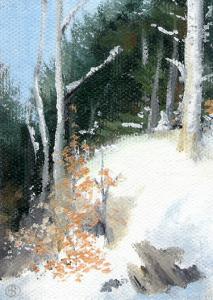Sale on canvas prints! Use code ABCXYZ at checkout for a special discount!

Newsletter March 2010
Greetings from the mountains of western Maine!
March has been all about seeing. You know those big signs they put on the driver’s ed. cars, the ones that say, “student driver”? I should be wearing one on my hat. I have been learning to see, and I feel like I am back in kindergarten, and I am enjoying it immensely. This month has not been “productive” in terms of shareable, saleable art output. But it has been a very important one in laying foundations for the work I will be doing next. The “seeing” has been going on in two arenas, in how I see the earth around me and in how I see the light that illumines it.
Last fall when I was in Cleveland I picked up a book called Seeing Nature at a used book sale for twenty-five cents, and it was a quarter well spent. Reading this book is changing the way I look at the world around me. It was written by Paul Krafel, a naturalist, educator, and former park ranger. If you haven’t read it yet, I highly recommend that you find a copy of it and take a thoughtful look. You will find Krafel on the internet at http://www.chrysalischarterschool.com/Paul/index.html.
Seeing Nature is about how nature works as a unified system, and the implications this has for us humans. (The subtitle is “Deliberate encounters with the visible world.”) In the chapter “Seeing Further into the Fourth Dimension” I found a fascinating concept that I have been able to apply to the land we live on here in the Swift River valley.
This property was a working farm when the nineteenth century gave way to the twentieth. But over the past few generations it has been left to grow back into what it was and still wants to be, a northern hardwood forest. It was not abandoned all at once, though, so each piece shows the evidence of its stage in the succession of regrowth.
Around the house we still have lawn, which is shorn regularly all summer, just like when it was farmland. Then there is abandoned lawn, which is turning back to meadow, and beginning to grow wildflowers and brambles and small shrubbery. Then we have the abandoned meadow, which is now growing small pines and aspen trees, the sun-loving species. And where the pines and aspens have grown to maturity, there is an understory of beech, oak, and sugar maple coming along, ready to take their places.
You can see the different parts of the property as a continuum in space—farm, meadow, softwoods, hardwoods. Or you can move your eyes through space and see into time. The areas that are now growing hardwood were once stands of small pine and aspen saplings, which were once meadow, which were once plowed fields. I can “see” backward in time to what my woods once looked like, and forward in time to what my lawn will look like in 100 years if we don’t mow it! This “time travel” seeing helps me to understand better how to take care of this place and how to cooperate with its innate patterns.
And about seeing light: Years ago I saw a light-filled painting by a current-day American impressionist and I thought, “I have GOT to learn to paint like that.” Finally the resources have caught up with me and I have been applying myself to really learn to see light and color. And I am producing some paintings—simple studies of colored blocks in the sunshine—that I am happier with than any oil paintings I have done so far.
Since this newsletter is already getting long enough, I am not going to go into more detail about this today. If you want more, you can see the blog titled “Boogie Chillen” which is available at the following link: http://betsy-bell.artistwebsites.com/blogs/boogie-chillen.html. There are photos there, too. And I am sure that you will be hearing more about this in newsletters to come.
I have attached a file of an art card here for you. This one is a miniature oil painting of the view across the road from the end of our driveway in the winter. I call it “Fox Den Hill” because the local foxes have their den someplace just on the other side. Art cards (or ACEO’s) are a collectible form of miniature art the same size as a baseball trading card. Print this one on good stiff photo paper, cut it out, and start your own collection, if you wish. I give you permission to print or reproduce this image as you choose.
For more information on “Swift River Treasures,” my artmaking process, or recent work, or to check out my blog, see my new website at http://betsy-bell.artistwebsites.com/index.html. Fine Art America has started formatting their artists’ pages into individual websites in addition to their FAA page. It has my own header on it, but through this site you can still access FAA’s great print-on-demand service with optional matting and framing. They also sell greeting cards with my work on them.
Begin the work even though you cannot see the path by which this work can lead to your goal. (Paul Krafel, in Seeing Nature)
Thanks for joining me in the journey. I hope that you enjoy looking at the art as much as I have enjoyed making it! I would love to hear from you, too, so please do reply with comments.
Betsy